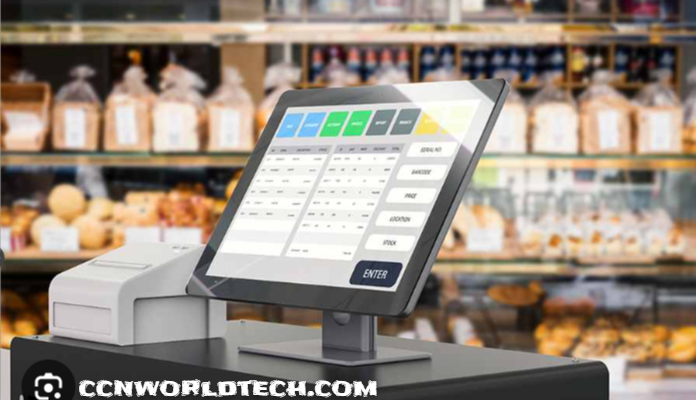Free POS Systems – Point of sale (POS) systems are essential tools for any business that sells products or services. They help you manage your inventory, track your sales, accept payments, and more. However, not all POS systems are affordable or suitable for small businesses. Some of them have high upfront costs, monthly fees, or complex features that you may not need.
Fortunately, some free POS systems offer basic functionality and flexibility for small businesses. These systems let you use your own devices, such as smartphones or tablets, to process transactions and manage your business. They also have low or no payment processing fees, and some of them offer additional features like online store integration, customer loyalty programs, or employee management.
In this article, we will review the five best free POS systems for small businesses in 2023, based on their features, ease of use, and customer reviews. We will also compare their pros and cons, and provide some tips on how to choose the best one for your business.
⇒Join us on Telegram for more Sure and Accurate football-winning tips every day...click here
Square: Best Overall Free POS System
Square is one of the most popular and widely used free POS systems in the world. It offers a simple and intuitive interface that works on any iOS or Android device. You can also use Square’s hardware, such as a contactless/chip reader or a stand, to create a more professional setup.
Square’s free POS system lets you accept all major credit cards, debit cards, mobile wallets, and cash payments. It also has a built-in payment processing service that charges a flat rate of 2.6% + 10 cents per transaction. You can also use Square to send invoices, track inventory, manage customers, create reports, and more.
One of the best features of Square is its integration with various third-party apps and services, such as QuickBooks, Shopify, Mailchimp, and more. You can also create your online store with Square for free, and sync your inventory and sales data across both platforms.
Square’s free POS system is ideal for general retail, restaurants, appointment-based service businesses, and more. However, if you need more advanced features, such as loyalty programs, marketing tools, payroll services, or multiple locations support, you will need to upgrade to one of Square’s paid plans, which start from $29 per month.
Pros:
- Easy to set up and use
- Works on any device
- Low payment processing fees
- Free online store integration
- Wide range of third-party integrations
Cons:
- Limited features on the free plan
- Customer service can be slow or unresponsive
Loyverse: Best for Quick-Service Restaurants
Loyverse is a free POS system designed specifically for quick-service restaurants and cafes. It allows you to take orders, print receipts, manage tables, track inventory, and more. You can use Loyverse on any iOS or Android device, or purchase a compatible receipt printer or cash drawer from Loyverse’s website.
Loyverse’s free POS system also has a built-in customer loyalty program that lets you reward your regular customers with points and discounts. You can also collect feedback from your customers via email or SMS surveys. Additionally, Loyverse provides you with detailed reports and analytics on your sales performance, inventory levels, customer behavior, and more.
Loyverse’s free POS system is suitable for small restaurants and cafes that need a simple and reliable solution to manage their operations. However, if you want to add more features, such as kitchen display system (KDS), employee management (EM), or advanced inventory (AI), you will need to pay extra fees per add-on per location.
Pros:
- Tailored for quick-service restaurants
- Free customer loyalty program
- Free feedback collection
- Comprehensive reports and analytics
Cons:
- No online store integration
- No third-party integrations
- Additional fees for add-ons
Toast: Best for Full-Service Restaurants
Toast is a free POS system designed for full-service restaurants. It offers a powerful and customizable interface that works on any Android device. You can also use Toast’s hardware, such as a handheld kit or a terminal, to create a more efficient workflow.
Toast’s free POS system lets you manage your menu, orders, tables, payments, tips, and more. It also has a built-in payment processing service that charges a flat rate of 2.49% + 15 cents per transaction. You can also use Toast to create online ordering, delivery, takeout, and catering services.
One of the best features of Toast is its integration with xtraCHEF, a cloud-based platform that automates your restaurant’s back-office tasks. You can use xtraCHEF to track your food costs, inventory, invoices, recipes, and more.
Toast’s free POS system is ideal for full-service restaurants that need a robust and flexible solution to manage their front-of-house and back-of-house operations. However, if you need more advanced features, such as loyalty programs, marketing tools, payroll services, or multiple locations support, you will need to upgrade to one of Toast’s paid plans, which start from $69 per month.
Pros:
- Customizable for full-service restaurants
- Free online ordering and delivery services
- Integration with xtraCHEF
- Flat payment processing fees
Cons:
- Limited features on the free plan
- Requires Android devices
- Expensive hardware and software upgrades
Helcim: Best Free POS with Cheap Payment Processing
Helcim is a free POS system that offers cheap payment processing for small businesses. It works on any iOS or Android device or any web browser. You can also use Helcim’s hardware, such as a card reader or a terminal, to accept payments in person.
Helcim’s free POS system lets you accept all major credit cards, debit cards, mobile wallets, and ACH payments. It also has a built-in payment processing service that charges an interchange plus fee of 0.40% + 8 cents per in-person transaction or 0.50% + 25 cents per online transaction. You can also use Helcim to send invoices, create subscriptions, manage customers, generate reports, and more.
One of the best features of Helcim is its transparency and honesty. Helcim does not charge any hidden fees, such as setup fees, monthly fees, cancellation fees, or PCI compliance fees. It also offers volume discounts and price-matching guarantees for its payment processing rates.
Helcim’s free POS system is suitable for retail, restaurant, service, and subscription businesses that want to save money on payment processing fees. However, if you want to add more features, such as inventory management (IM), employee management (EM), or customer relationship management (CRM), you will need to pay extra fees per add-on per month.
Pros:
- Works on any device or browser
- Cheap payment processing fees
- Transparent and honest pricing
- Volume discounts and price-matching guarantees
Cons:
- No online store integration
- No third-party integrations
- Additional fees for add-ons
PayPal Zettle: Best for Solopreneurs and PayPal Users
PayPal Zettle is a free POS system that works with PayPal, one of the most popular and trusted online payment platforms. It allows you to accept payments from any device, such as a smartphone, tablet, or laptop. You can also use PayPal Zettle’s hardware, such as a card reader or a printer, to create a more professional setup.
PayPal Zettle’s free POS system lets you accept all major credit cards, debit cards, mobile wallets, and PayPal payments. It also has a built-in payment processing service that charges a flat rate of 2.7% per transaction. You can also use PayPal Zettle to send invoices, track sales, manage inventory, and more.
One of the best features of PayPal Zettle is its integration with PayPal’s other products and services, such as PayPal Business Debit Mastercard, PayPal Checkout, PayPal Here, and more. You can also access your funds instantly in your PayPal account, or transfer them to your bank account within one business day.
PayPal Zettle’s free POS system is ideal for solopreneurs and PayPal users who want to accept payments online and offline with ease and security. However, if you need more advanced features, such as loyalty programs, marketing tools, payroll services, or multiple locations support, you will need to use third-party integrations or switch to another POS system.
Pros:
- Works with any device
- Integrates with PayPal’s products and services
- Flat payment processing fees
- Instant access to funds
Cons:
- Limited features on the free plan
- No online store integration
- No native third-party integrations
Stripe: Best for Application Programming Interface (API)
Stripe is a free POS system that offers a powerful and flexible API for developers and businesses. It allows you to create your own custom POS solution that works on any device or platform. You can also use Stripe’s hardware, such as a card reader or a terminal, to accept payments in person.
Stripe’s free POS system lets you accept all major credit cards, debit cards, mobile wallets, and alternative payment methods. It also has a built-in payment processing service that charges an interchange plus fee of 2.9% + 30 cents per transaction. You can also use Stripe to send invoices, create subscriptions, manage customers, generate reports, and more.
One of the best features of Stripe is its extensive documentation and support for developers and businesses. You can use Stripe’s API to integrate with various third-party apps and services, such as Shopify, WooCommerce, QuickBooks, Mailchimp, and more. You can also customize your POS solution to fit your specific needs and preferences.
Stripe’s free POS system is suitable for developers and businesses that want to create their own unique POS solution with a powerful and flexible API. However, if you want to use a ready-made POS solution with a simple and intuitive interface, you may find Stripe too complex or overwhelming.
Pros:
- Works on any device or platform
- Offers a powerful and flexible API
- Supports various payment methods
- Provides extensive documentation and support
Cons:
- Requires coding skills
- No online store integration
- Interchange plus payment processing fees
In conclusion, free point-of-sale systems can help small businesses save money and improve their operations. However, not all free POS systems are created equal. Depending on your business type, budget, needs, preferences, and integrations, you may find some free POS systems more suitable than others.
Frequently Asked Questions (FAQ): Free POS Systems: Best 5 for Small Businesses in 2023

What is a point-of-sale system?
A point of sale (POS) system is software that helps you manage your sales transactions, inventory, customers, employees, and more. A POS system usually consists of a device (such as a smartphone, tablet, or terminal) that runs the POS software and hardware (such as a card reader, printer, or cash drawer) that connects to the device.
Why do I need a POS system for my small business?
A POS system can help you streamline your business operations, improve your customer service, and increase your sales. With a POS system, you can:
- Accept various payment methods, such as credit cards, debit cards, mobile wallets, and cash
- Track your inventory levels, costs, and profits
- Manage your customers’ information, preferences, and loyalty
- Generate reports and analytics on your business performance
- Integrate with other apps and services, such as accounting, e-commerce, marketing, and payroll
How do I choose the best POS system for my small business?
There are many factors to consider when choosing a POS system for your small business, such as:
- Your business type and industry: Different POS systems may have different features and functions that suit different types of businesses, such as retail, restaurant, service, or subscription.
- Your budget and needs: Some POS systems are free or low-cost but may have limited features or charge extra fees for add-ons or payment processing. Some POS systems are more expensive but may offer more advanced features or lower payment processing fees.
- Your device and hardware preferences: Some POS systems work on any device or browser, while some require specific devices or platforms. Some POS systems provide their hardware, while some let you use your hardware or purchase from third-party vendors.
- Your integration and customization options: Some POS systems have built-in integrations with various third-party apps and services, while some require you to use their products or services. Some POS systems offer a powerful and flexible API that lets you create your own custom POS solution.
What are the benefits of using a free POS system?
Using a free POS system can help you save money on software fees and hardware costs. You can also test out different features and functions without committing to a long-term contract or subscription. A free POS system can also help you get started quickly and easily with minimal setup and training.
What are the drawbacks of using a free POS system?
Using a free POS system may have some limitations and disadvantages, such as:
- Limited features and functions: A free POS system may not have all the features and functions that you need for your business, such as inventory management, employee management, customer relationship management, loyalty programs, marketing tools, payroll services, or multiple locations support.
- Additional fees: A free POS system may charge extra fees for add-ons or payment processing. These fees may vary depending on the provider, the plan, the location, or the transaction volume.
- Lack of support and security: A free POS system may not provide adequate customer service or technical support. It may also not have sufficient security measures or data protection policies to safeguard your business information and transactions.




